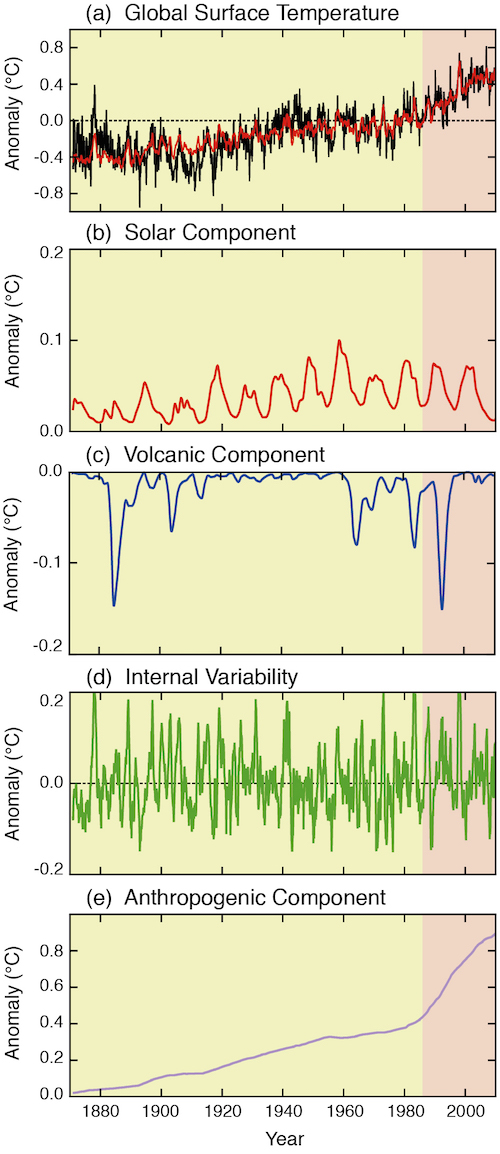 Arguments
Arguments
 Software
Software
 Resources
Comments
Resources
Comments
 The Consensus Project
The Consensus Project
 Translations
Translations
 About
Support
About
Support


Latest Posts
- Skeptical Science New Research for Week #49 2025
- Climate Adam & Dr Gilbz - Paris Climate Agreement At 10: Did It Do Anything?
- Fact brief - Does the recent slowdown in Arctic sea-ice extent loss disprove human-caused warming?
- Why the chemtrail conspiracy theory lingers and grows – and why Tucker Carlson is talking about it
- 2025 SkS Weekly Climate Change & Global Warming News Roundup #48
- Skeptical Science New Research for Week #48 2025
- Consensus machines
- Just have a Think - How an African energy revolution could save ALL of us.
- A girl’s grades drop every summer. There’s an alarming explanation.
- 2025 SkS Weekly Climate Change & Global Warming News Roundup #47
- Fact brief - Are changes in solar activity causing climate change?
- Skeptical Science New Research for Week #47 2025
- Exploring newly released estimates of current policy warming
- Climate Adam - Why the Climate Crisis is a Health Crisis
- Super pollutants are trendy, but we should be careful how we use them
- 2025 SkS Weekly Climate Change & Global Warming News Roundup #46
- Skeptical Science New Research for Week #46 2025
- On the Gates climate memo
- Climate Adam - Climate Scientist responds to Bill Gates
- Five ways Joe Rogan misleads listeners about climate change
- 2025 SkS Weekly Climate Change & Global Warming News Roundup #45
- Skeptical Science New Research for Week #45 2025
- Debunking Joe Rogan, Dick Lindzen, and Will Happer
- Fact brief - Does cold weather disprove human-caused climate change
- Climate change strengthened Hurricane Melissa, making the storm’s winds stronger and the damage worse.
- 2025 SkS Weekly Climate Change & Global Warming News Roundup #44
- Skeptical Science New Research for Week #43 2025
- Climate Adam - Can Solar Halt the Desert?
- Fact brief - Is there empirical evidence for human-caused global warming?
- A “controversial” methane metric?
Archived Rebuttal
This is the archived Basic rebuttal to the climate myth "It's the sun". Click here to view the latest rebuttal.
What the science says...
|
The sun's energy has decreased since the 1980s but the Earth keeps warming faster than before. |
Over the last 35 years the sun has shown a cooling trend. However global temperatures continue to increase. If the sun's energy is decreasing while the Earth is warming, then the sun can't be the main control of the temperature.
Figure 1 shows the trend in global temperature compared to changes in the amount of solar energy that hits the Earth. The sun's energy fluctuates on a cycle that's about 11 years long. The energy changes by about 0.1% on each cycle. If the Earth's temperature was controlled mainly by the sun, then it should have cooled between 2000 and 2008.

Figure 1: Annual global temperature change (thin light red) with 11 year moving average of temperature (thick dark red). Temperature from NASA GISS. Annual Total Solar Irradiance (thin light blue) with 11 year moving average of TSI (thick dark blue). TSI from 1880 to 1978 from Krivova et al 2007. TSI from 1979 to 2015 from the World Radiation Center (see their PMOD index page for data updates). Plots of the most recent solar irradiance can be found at the Laboratory for Atmospheric and Space Physics LISIRD site.
The solar fluctuations since 1870 have contributed a maximum of 0.1 °C to temperature changes. In recent times the biggest solar fluctuation happened around 1960. But the fastest global warming started in 1980.
Figure 2 shows how much different factors have contributed recent warming. It compares the contributions from the sun, volcanoes, El Niño and greenhouse gases. The sun adds 0.02 to 0.1 °C. Volcanoes cool the Earth by 0.1-0.2 °C. Natural variability (like El Niño) heats or cools by about 0.1-0.2 °C. Greenhouse gases have heated the climate by over 0.8 °C.

Figure 2 Global surface temperature anomalies from 1870 to 2010, and the natural (solar, volcanic, and internal) and anthropogenic factors that influence them. (a) Global surface temperature record (1870–2010) relative to the average global surface temperature for 1961–1990 (black line). A model of global surface temperature change (a: red line) produced using the sum of the impacts on temperature of natural (b, c, d) and anthropogenic factors (e). (b) Estimated temperature response to solar forcing. (c) Estimated temperature response to volcanic eruptions. (d) Estimated temperature variability due to internal variability, here related to the El Niño-Southern Oscillation. (e) Estimated temperature response to anthropogenic forcing, consisting of a warming component from greenhouse gases, and a cooling component from most aerosols. (IPCC AR5, Chap 5)
Some people try to blame the sun for the current rise in temperatures by cherry picking the data. They only show data from periods when sun and climate data track together. They draw a false conclusion by ignoring the last few decades when the data shows the opposite result.
Basic rebuttal written by Larry M, updated by Sarah
Update July 2015:
Here is a related lecture-video from Denial101x - Making Sense of Climate Science Denial
Updated on 2017-04-02 by Sarah.
THE ESCALATOR

(free to republish)
























































